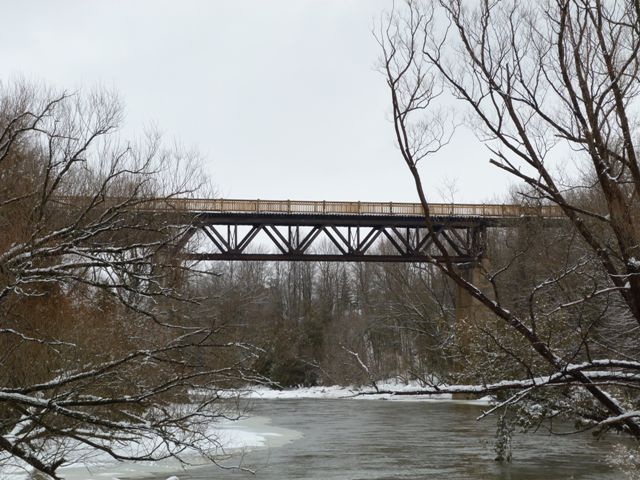We Recommend:
Bach Steel - Experts at historic truss bridge restoration.
BridgeHunter.com Phase 1 is released to the public! - Visit Now
Paisley Railway Bridge

Primary Photographer(s): Nathan Holth and Luke Gordon
Bridge Documented: March 13, 2011
Not Available or Not Applicable
Not Available
607.0 Feet (185 Meters)
Not Available
1 Main Span(s)
Not Applicable

View Information About HSR Ratings
Bridge Documentation
View The Original Patent For Phoenix Columns
View A Phoenix Column Diagram From A Phoenix Bridge Company Brochure
Railway service came to Paisley in 1872, and at that time a bridge was provided. Since that time, the bridge was reconstructed many times. However it appears that perhaps the bridge was never completely demolished and replaced, and instead was replaced in a piecemeal fashion over the years. The main concrete piers for the bridge appear to have 1926 cast into them, and since the main deck truss span rests on this it would seem the truss dates to 1926. More piers and spans were replaced in 1947.
The most significant aspect of this bridge is not the bridge seen today, but the remnants of the previous bridge. While snow made it impossible for HistoricBridges.org to document them, this website has a photo that clearly shows the bents from the previous bridge. They are wrought iron Phoenix columns, one of the rarest and most unusual built-up beams in existence. Patented and manufactured by the Phoenix Bridge Company and their associated Phoenix Iron Works, both based in Phoenixville, Pennsylvania, these beams are today extremely rare in the United States and nearly unheard of in Canada with perhaps only two or three bridges remaining in the country with Phoenix columns. Phoenix columns are extremely significant from a historical standpoint because they are a record of one of the many propriety beam and column designs that different companies came up with as they experimented with this relatively new building material called wrought iron. The Phoenix columns under this bridge are abandoned under the bridge and forgotten, and the majority of them appear to be buried in dirt. They could be excavated out of the ground and restored and relocated someplace where more people could see and learn about them. They would not be out of place in a museum. Alternatively, they perhaps could somehow be preserved in place in a manner that protects them from deterioration. Interpretive signage should be installed on the site to inform visitors of the significance of the Phoenix Columns.
Perhaps just under a kilometer west of this bridge there is another high level railroad bridge that crosses the smaller Willow Creek. Time and weather did not permit HistoricBridges.org to visit the bridge, but it is a deck plate girder bridge (no truss spans). Its coordinates are 44.30309 -81.28462 and photos can be found on this website.
A historical photo of the Phoenix Column bridge can be seen here and another view is here.
This bridge is tagged with the following special condition(s): Phoenix Columns
![]()
Photo Galleries and Videos: Paisley Railway Bridge
Bridge Photo-Documentation
Original / Full Size PhotosA collection of overview and detail photos. This gallery offers photos in the highest available resolution and file size in a touch-friendly popup viewer.
Alternatively, Browse Without Using Viewer
![]()
Bridge Photo-Documentation
Mobile Optimized PhotosA collection of overview and detail photos. This gallery features data-friendly, fast-loading photos in a touch-friendly popup viewer.
Alternatively, Browse Without Using Viewer
![]()
Maps and Links: Paisley Railway Bridge
Coordinates (Latitude, Longitude):
Search For Additional Bridge Listings:
Additional Maps:
Google Streetview (If Available)
GeoHack (Additional Links and Coordinates)
Apple Maps (Via DuckDuckGo Search)
Apple Maps (Apple devices only)
Android: Open Location In Your Map or GPS App
Flickr Gallery (Find Nearby Photos)
Wikimedia Commons (Find Nearby Photos)
Directions Via Sygic For Android
Directions Via Sygic For iOS and Android Dolphin Browser

